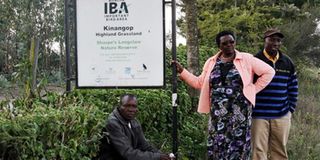Group on a mission to save Kinangop’s endangered bird

Some members of the Kinangop-based conservation group. They have been sensitising locals on the need to save the endangered Sharpe's Longclaw bird. PHOTO/CHEBET CAROLINE
What you need to know:
- Wildlife Explorers describe it as ‘a very localised and endangered Kenyan species, found in grasslands of the central highlands.’
- The Longclaw is a genus of small African passerine birds with a long tail, which it wags frequently.
- Though the number of the birds was estimated at 700 pairs eight years ago.
- Inbreeding is said to have also reduced the number of eggs laid, thus affecting population growth.
As you drive around most villages in Kinangop, Nyandarua County, nothing unusual catches your attention at first.
Farmers go about their businesses as usual in this mainly agricultural area.
It is harvest time and most of them are harvesting potatoes and peas.
This season’s harvest seems a bit low. There are no many lorries ferrying produce from farms like other times in such a season.
But most farmers in Githunguri village are of a kind. They have some uncultivated parts of their small pieces of land.
Initially, one would be forgiven for thinking that the uncultivated pieces are grazing zones for their animals.
But no. It is based on a decision by the community here to conserve the Sharpe's Longclaw, an endangered bird species.
Scientifically known as Macronyx Sharpei, Wildlife Explorers describe it as ‘a very localised and endangered Kenyan species, found in grasslands of the central highlands.’
LONG TAILS
The Longclaws is a genus of small African passerine birds with a long tail, which it wags frequently.
The idea to help conserve this rare bird was mooted by seven neighbours 18 years ago.
They had just cleared school, when they noticed that deforestation was getting worse by the day.
Most of their parents were former freedom fighters who were resettled in the area after independence thus they never got any education.
“But we had some education and have learnt the benefits of conserving the environment” says John Mungai Gathu, the Chairman of Friends of Kinangop Plateau.
Four young men and three women, all age mates, decided to take walks around the village preaching the gospel of conserving the environment.
Notable was the decreasing number of the Sharpe's Longclaw birds which the group had enjoyed watching throughout their lives.
“We realised the birds had started migrating and we feared that our children would not have the leisure of living with these birds as we did,” says Gathu.
The community had reaped many benefits from living with the Sharpe's Longclaw bird over the years.
The birds fed on insects that destroyed crops. This saved farmers on money they would have lost due to crop destruction.
HARMFUL CHEMICALS
Currently, the birds not only eat insects but also act as an alarm to farmers when they use harmful chemicals.
“If we spot a carcass of the Sharpe's Longclaw, we normally remove blood and send the sample to a laboratory in Switzerland so that we can find out the cause of death,” says Andrew Waweru, one of the group’s founding members.
For at least three times, the group has alerted farmers to cease using particular chemicals in their farms after they found high toxicity which could harm humans.
Kinangop Plateau Conservation Group has partnered with Nature Kenya, among other conservation groups to enlighten farmers on proper land management.
“We advise them to leave some land uncultivated because the bird cannot live in cultivated land,” says Gathu.
However, some farmers have rejected this advice owing to the growing population which has reduced the amount of land they own.
Currently, the group has reached over 20,000 people with the message of conservation though it only has 40 active members.
ATTRACTS VISITORS
Sharpe's Longclaw has been attracting visitors from all over the world.
Every year, more than 500 local and international tourists go to Githunguri to see the Sharpe’s Long Claw and learn about conservation.
Though the number of the birds was estimated at 700 pairs eight years ago when the first census was conducted, it has gone down to 300 pairs as of the 2013 count.
The area’s population rose sharply from 2008 after many people who had been displaced during the 2007-2008 post-election violence bought land and settled there.
“Each pair of the birds needs at least 7 acres of uncultivated land for it to be comfortable,” says Gathu.
But the increasing number of people who predominately depend on farming has decreased the amount of uncultivated land.
Inbreeding is said to have also reduced the number of eggs laid, thus affecting population growth.





